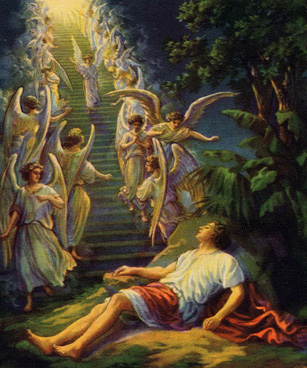"A New Approach to Revelation" by Tricia Tillin (Part Eight)
how the day of atonement Temple service sheds light on the book of revelation: The Throne Room
We proceed now into the Heavenly part of this vision. Although in one sense everything that John of Revelation has seen so far is a 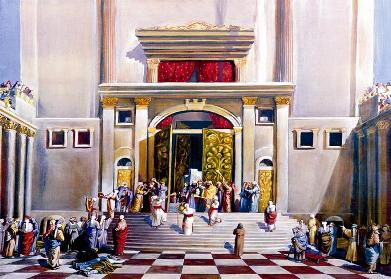 prophetic vision, and therefore a spiritual or heavenly event, in terms of location he has been on earth up to now.
prophetic vision, and therefore a spiritual or heavenly event, in terms of location he has been on earth up to now.
John has heard about earthly events, such as the Church and its earthly mission, and his location is therefore (as regards the Jerusalem Temple) in the Court of the common people - that is, the so-called Women's Court outside the Sanctuary.
John now obeys the command to "come up here" and he ascends to Heaven. This is like ascending the impressive 15-step staircase from the womens' Court up to the glorious and immense Nicanor Gate seen here in this illustration, and entering into an altogether more sacred space.
From now on John tells us about what is going on with regard to the High Priest, Jesus Christ, and his servants. He begins by describing the scene. But before we take up the story inside the Heavenly Temple, let's see what this staircase really represents.
![]() Go Back to Summary/Contents Page
Go Back to Summary/Contents Page
Stairway to Heaven
This immense and impressive set of stone steps leading up to the Nicanor Gate was broad and deep. It raised the Sanctuary part of the Temple seven meters above the Womens' Court. As I have said, it also made a division between the place for the common people (albeit God's people) and the Sanctuary area where sacrifices and other rituals took place. 
In terms of the book of Revelation, it marked John's departure from the ordinary earthly realm of worship to a higher realm, not ordinarily seen.
Here on the Nicanor steps, the Levite musicians and singers of Herod's Temple would assemble to accompany the services, performing their sacred music on a kind of platform above the people. In this way, the men and women who had no sight nor access into what was going on beyond, could know at what point of the service they were, and what was the appropriate response.
Therefore, the role of the trumpets was vital. They announced the opening of the great Sanctuary door, the sacrifice, and the libation of wine and they also gave a three-fold blast during the pauses in the recitation of the Psalm of the day.
We find from reading contemporary literature and discussions thereon, that the arrangement of the trumpeters was not just in a straight line across the top of the steps, but in two descending ranks on either side of the great staircase. Could this be the location of the angelic trumpeters of Revelation therefore? I believe so!
Jacob's Ladder
This arrangement brings to mind an Old Testament scripture in which Jacob surely saw a similar vision to John, and even saw the identical heavenly staircase (equivalent to the stairs up to the Nicanor Gate) in his dream. There is always consistency in the bible.
Genesis 28:10-19, Jacob ... dreamed, and behold, there was a ladder set up on the earth, and the top of it reached to heaven; and behold, the angels of God were ascending and descending on it! And behold, the Lord stood above it [or "beside him"] and said, "I am the Lord, the God of Abraham your father and the God of Isaac; the land on which you lie I will give to you and to your descendants; ...." Then Jacob awoke from his sleep and said, "Surely the Lord is in this place; and I did not know it." And he was afraid, and said, "This is none other than the house of God, and this is the gate of heaven".
The word 'ladder' gives us the wrong impression, for the Hebrew word was 'sulam' or 'salam' which is used only once in the entire bible. Therefore, it is difficult to pin down an exact meaning but it derives from the words for a ramp, or staircase. Among researchers there is no unanimity on this question. 'Sulam' may be derived from the Akkadian "simmiltu' meaning a system of ascent, steps upwards, such as in the Ziggurat. Alternatively it may be derived from the root Hebrew Sl"l, or a Battery Ramp .In the NIV translation of the Bible, the term "stairway" is used instead of ladder.
We notice that Jacob sees not only the stairway but believes he has been privileged to experience heaven itself, the "house of God". When he awoke, he believed that God was present in that place. He took the stone he had been using to rest his head, poured oil on it and consecrated it to God. Then he called the place Bethel, meaning "house of God."
Most scholars interpret Jacob's ladder as a connection between heaven and earth, with God taking the initiative to reach out to man. The perfect "ladder" is Jesus Christ, who is God come to earth to save mankind, therefore bridging the two realms.
Jesus refers to himself as this ladder in John 1:51: "And he (Jesus) said to him, 'Truly, truly I say to you, you will see heaven opened, and the angels of God ascending and descending on the Son of Man.'" (ESV) Jesus is the WAY or GATE into Heaven, the House of God. What both Jacob and John saw was a representation of this Way, but the gate is also reproduced both in the earthly and heavenly tabernacle as a wonderful and impressive doorway with a staircase.
John enters Heaven via Jesus, the Way
Now that the similarities between Jacob's and John's stairway can be seen, and adding the information about the precise location of the trumpeters during the vision of Revelation, we can more easily understand their role. We can understand that the trumpets are warnings, or announcements, made to ordinary people that events are taking place behind the Sanctuary doors that will impact everyone on earth.
Later on, we find out that the trumpets blew during the pouring out of the WINE. It causes us to realise that there is a relationship between the TRUMPETS and the BOWLS in the book of Revelation - and indeed the descriptions of each are nearly identical. However, the bowl judgements, when they actually begin, are in fact greater in scope and intensity than the trumpets had announced!
The Throne Room
Having ascended the staircase, John enters the Sanctuary area of Heaven. He describes the scene in the only words he has - human words of course. They are inadequate to tell us the exact splendour of Heaven, but we have to make do with his description, alongside similar biblical accounts in the Old Testament.
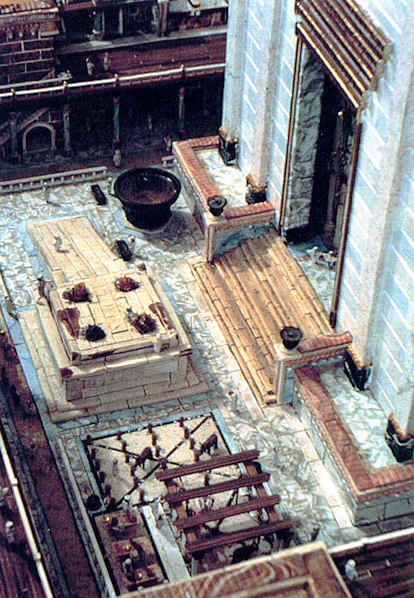
In Herod's Temple John would have discovered the area used only by priests. Their court surrounded and fronted the inner sanctuary itself.
Here we see a model of that area.
It contained the great stone altar of sacrifice with its woodpile fires for burning offerings, a huge bronze laver for ritual washing of hands and feet, an area for the tethering and slaughter of animals, and the steps up to the vestibule of the Holy Place.
On the far left [bottom] is the small area called the Court of Israel where some 24 accredited representatives of the nation could assemble to watch the sacrifices.
What John sees in Heaven is similar but in important ways different: he sees no division between the inner and outer areas but all are disclosed to him immediately. Upon entering heaven he sees "a throne set in heaven and One sat upon the throne..." Rev 4:2. This would, in earthly terms, be the Ark of the Covenant in the Holy of Holies which would never be seen by the common man.
In the description given to Moses (who was to build a replica of the Throne-room) that Ark - and its mercy-seat throne of God on earth - had winged covering angels upon it. Here in heaven we see the real four covering angels around the throne. They are the Cherubim described in the Old Testament, Exod 25:17-19 "You shall make a mercy seat of pure gold, two and a half cubits long and one and a half cubits wide. You shall make two cherubim of gold, make them of hammered work at the two ends of the mercy seat. Make one cherub at one end and one cherub at the other end; you shall make the cherubim of one piece with the mercy seat at its two ends.…"
The atonement cover was the lid for the ark. On top of it stood two cherubim (angels) at the two ends, facing each other. The cherubim, symbols of God's divine presence and power, were facing downward toward the ark with outstretched wings that covered the atonement cover. The whole structure was beaten out of one piece of pure gold. The atonement cover was God's dwelling place in the tabernacle. It was His throne, flanked by angels. God said to Moses: "There, above the cover between the two cherubim that are over the ark of the Testimony, I will meet with you and give you all my commands for the Israelites." (Exodus 25:22) "Tell your brother Aaron not to come whenever he chooses into the Most Holy Place behind the curtain in front of the atonement cover on the ark, or else he will die, because I appear in the cloud over the atonement cover." (Leviticus 16:2) Other Scriptures also speak of God's throne: "…the ark of God, which is called by the Name, the name of the Lord Almighty, who is enthroned between the cherubim that are on the ark." (2 Samuel 6:2) "O Lord Almighty, God of Israel, enthroned between the cherubim, you alone are God over all the kingdoms of the earth." (Isaiah 37:16) Above the ark and the atonement cover, God appeared in His glory in "unapproachable light" (1 Timothy 6:16). This light is sometimes referred to as the Shekinah glory. The word Shekinah, although it does not appear in our English bibles, has the same roots as the word for tabernacle in Hebrew and refers to the presence of the Lord. [Source]
The Brazen Sea
Not immediately, but during the course of John's vision, he also sees other objects in the heavenly Temple, with which he would be familiar, as a Jew. Again, there are important omissions.
The Priests' Court seen above had an area set apart for the sacrifice of animals which understandably does not exist in Heaven. Also, the huge bronze laver for purification - called in the Old Testament the "Bronze Sea" - is not mentioned, unless it is the "crystal sea" of Rev 4:6. This sounds more likely on discovering that the Old Testament version was made from the mirrors donated by Jewish women. (see here).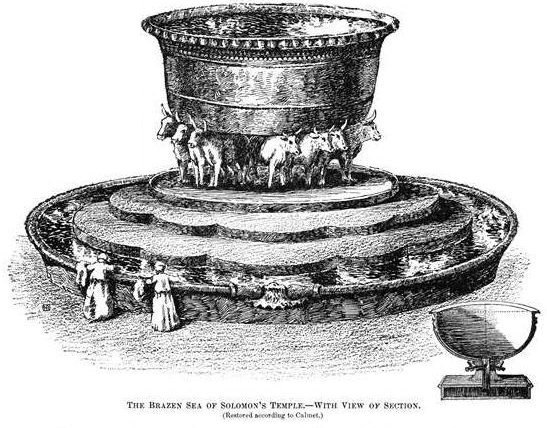
The symbolism of the brazen sea is described in detail in the Midrash 'Tadshe'. "The sea represented the world;... The two rows of colocynths (knops) below the rim were symbolic of the sun and the moon, while the twelve oxen on which the sea rested represented the zodiac ("mazzalot")."
Nonetheless, it is hard to imagine John and others "standing on the glassy sea" as the bronze laver in Heaven, nor is it clear why they would. It seems to me that water purification is not necessary for anybody in Heaven! I prefer to believe therefore that the crystal sea before the throne is the "firmament" seen by other visitors to Heaven, and is therefore an attempt to explain how Heaven is surrounded by, and has its foundation upon, the purest crystal atmosphere, unlike anything known to mankind.
Ezek 1:22 22 "Now over the heads of the living beings there was something like an expanse, like the awesome gleam of crystal, spread out over their heads."
(Remember here that Ezekiel saw the throne descending to earth, thus the "crystal sea" that he saw was ABOVE the throne and the four living creatures, not BELOW it.)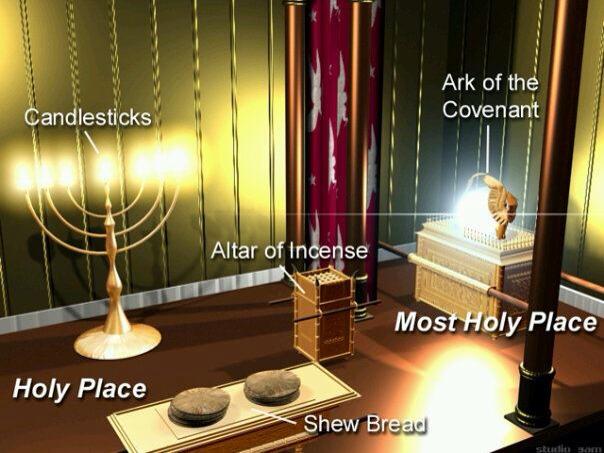
The Menorah
Inside the Holy Place within the Tabernacle and also Herod's Temple Sanctuary were three main objects, two of which John describes as also being in Heaven. Again the item he omits is intriguing. The seven-branched candle-holder, or "menorah" as it is called stood sideways on the left, and on the opposite side was the "table of shewbread". Between them was the golden altar of incense.
John mentions the "seven spirits before the throne" as being the reality of the seven lights in that holy place. [See this page for a short discussion on the seven spirits of God] In truth, that which gives light to the world is Jesus Christ, who indeed called himself "The Light of the World" in John 8:12.
Furthermore, Jewish literature speaks of the Temple Menorah in similar terms. The light was not placed there (they say) in order to illuminate the inner sanctuary itself but conversely, in order to shine OUT from it to give "light to the world". [Source]
"Originally, the Menorah was a seven-branched candelabra beaten out of a solid piece of gold ... Only pure, fresh olive oil of the highest quality was suitable to light the Menorah....[which] endures as a symbol of Divine light spreading throughout the world. To this end, God commanded that the Menorah's goblets be turned upside down on their stems, emphasizing the importance of spreading light to others. This design reflects the Menorah's exact purpose in the Holy Temple, which was to spread the light of Godliness to the entire world, not to illuminate the Temple itself. The seven lamps of the Menorah also allude to knowledge, with six of the branches representing human wisdom, guided by the center branch of Divine light. The Menorah's design and the ideas it communicates endure as an inspiration for universal enlightenment." [Source]
Thus, what John sees in heaven are the seven spirits of God mentioned in Isaiah 11:2, as well as the power (horns) and wisdom (eyes) of the Lamb, Jesus in Revelation 5:6. Collectively they are the Holy Spirit of God which descended to the Church at Pentecost and is sent out "into all the earth" to preach the gospel.
The Golden Altar of Incense
So much for the Menorah. But what of the altar of incense? John also sees this in Heaven. (Rev 8:3) We are told that incense is symbolic of the "prayers of the saints" in Rev 5:8 so there is an obvious role for the golden altar of incense before the Throne. However, the missing item is the table containing the loaves of bread.
The Table of Shewbread
This item, the Table of Shewbread as we call it, containing the " Bread of the Presence" would have been well known to John, so failing to mention it as present in the heavenly Temple is important. [An alternative, and more appropriate, translation would be presence bread, since the Bible requires that the bread be constantly in the presence of God (Exodus 25:30).]
The number of the loaves laid on the table - twelve - suggests that the bread was not intended as an offering to God which is how the Assyrians and Babylonians used them, but rather, as a remembrance of the twelve tribes of Israel who were continually in the presence and sight of God. They were made of fine flour, unleavened. Some writers suggest that incense and salt were applied to or incorporated into the loaves - these three facts symbolising the purity and sanctity of the bread. Thus they spoke of the redeemed people of God.
Literally, the Hebrew that is translated "showbread" is lechem ha'panim, that is, "bread of the faces" -- or, "bread of the Presence (of God)."The PLURAL form of "faces" is used, panim. So this could also be a reference to the "faces" of the twelve tribes of Israel, as they appear before God, represented by the loaves of bread.
That being the case, why is the table of shewbread not seen in heaven, standing before the Throne? I would like to suggest that they ARE, but in a completed form. No longer represented as loaves of bread, the redeemed of Israel are surrounding the Throne - seated and crowned - along with an equally representative number of New Testament elders. There as the 24 elders they are "ever before the Lord" and in continual praise and worship to him.
The Throne of God
The prophets are entirely consistent in their descriptions of heaven. Micaiah's account (1 Kings 22:19) is the first detailed depiction of a heavenly throne room in Judaism and it speaks of God's throne surrounded by his angels. Isaiah (Isaiah 6) adds to this the seraphim with covering wings, the altar (of incense?) from which the angel took a burning coal, and Ezekiel (Ezekiel 1) goes further still. He sees a "raging fire" as the background of the throne, the four living creatures in greater detail, the firmament over their heads and the throne of God itself set in sapphire with God described as like fire and amber. He also sees the rainbow around the throne just as John did.
Isaiah sees what John describes as the four living creatures (which themselves are reflected in the Seraphim covering the Ark in the Tabernacle.) In Isaiah 6:3 we read that these seraphim call "Holy, holy, holy" which is exactly what John hears in Heaven from the four living creatures in Revelation 4:8. But this also is heard during the Temple liturgy:
"Immediately, the reader of the prophetic portion goes in and holds the Torah and chants: "Hear O Israel, the Eternal is our God, the Eternal is One". (Dt. 6:4, shema.) And the people repeat after him, and he repeats and says: "One is our God, great is our Lord: HOLY. One is our God, merciful is our Lord: HOLY. One is our God, great is our Lord: HOLY and awesome is His Name"." [Source]
Daniel (Daniel 7:9) confirms the likeness of the "Ancient of Days" as a mixture of the purest white and fiery flame, with thousands and thousands of attendant angels. Zechariah (Chapter 3) depicts a vision of the heavenly throne room where he meets the "Angel of the Lord" who is surely Jesus, and sees the golden lampstand with seven lamps burning before the throne; later he also sees - as did John - the four horses and chariots sent out into the earth (the "four spirits of heaven" 6:5) as judgements of God.
The Dead Sea Scrolls and various apocryphal books speak of the throne-room as a mixture of fire and ice - suggesting both the brightness of God's divine glory, and the crystal sea.
All of this suggests interpretations to what John of Revelation said. For example:
- The four living creatures (4:7) are connected to and representative of the four spirits of heaven (7:1 where the word for 'wind' is identical to that of 'spirit')
- They are also, according to Zechariah, sent out in judgement to the four quarters of the world.
- And thus they also have a connection to the four horses/horsemen of Revelation chapter 6. where the four living creatures are responsible for sending forth the four horse judgements. (This is examined in my studies on the four creatures elsewhere.)
- The seven spirits before the throne seen in Revelation 4:5 (depicted in Herod's Temple as the seven-branched Menorah) have a connection to the Two Witnesses later described in Revelation 11:4, as the angel specifically refers to the two olive trees of Zechariah 4:2.
- These seven spirits have a connection to the seven churches (Rev 3:1, 15:6) which collectively are the 'eyes' of God throughout the earth.
The Green Rainbow
Likewise, we can question the colour of the rainbow around the throne which is translated "emerald" in most bibles today. (Rev 5:4:3) The Old Testament accounts tell us this is not so. Again, my study on that subject - and the other gems of the bible - will be found elsewhere on the website in due course, so as not to stretch out these pages too far. But the testimony of the scriptures overall is that the throne of God is surrounded by fire and light.
Easton's Bible Dictionary says this: "Hebrews nophek (Exodus 28:18; 39:11); i.e., the "glowing stone", probably the carbuncle, a precious stone in the breastplate of the high priest. It is mentioned (Revelation 21:19) as one of the foundations of the New Jerusalem. The name given to this stone in the New Testament Greek is smaragdos, which means "live coal." I think a glowing white-hot live coal is a much more accurate description of the fire, light and glory surrounding God's throne!
The 24 Elders
Here we come to a very contentious section of Revelation. The identity of the 24 elders that John sees surrounding the Throne is vigorously defended on all sides. What does scripture show us about these people, and what does the Temple setting demonstrate? I have made one suggestion above - that they are representatives of each of the tribes of Israel (once represented by 12 loaves on the table of shewbread) and an equal number of the saved of the Church.
There is also another hint given in Jewish literature, which refers to the 24 Jewish men that are chosen to represent their nation on feast days, when it would be impossible to allow all visitors to view the procedings in the Temple. These 24 are the ones who are allowed to pass beyond the gate and stand in the special portion of the Priests' Court. To John therefore, these 24 men are representative of "Israel" as a nation.
We have two other contenders: the Sanhedrin or Council of Israel which met in the Temple and consisted of 23 members (or 71 on important occasions) and secondly the 24 courses of priests who attended to the Temple services on a rota system.
To be brief here (with additional material found via the Index page) the 24 elders are human beings not angels (for they claim to have been redeemed Rev 5:9) and are also in that verse called "kings and priests". Priests they are, since they have harps, and bowls of incense, and sing praises to God (Rev 5:8). But John applies this to himself and all believers in Revelation 1: 6 "and has made us to be a kingdom and priests to serve his God and Father".
It is first applied to Israel, so long as they stay obedient to God, and later to the redeemed of Israel, that is the Church:
Exodus 19:5 'Now then, if you will indeed obey My voice and keep My covenant, then you shall be My own possession among all the peoples, for all the earth is Mine; and you shall be to Me a kingdom of priests and a holy nation.' These are the words that you shall speak to the sons of Israel. So Moses came and called the elders of the people, and set before them all these words which the LORD had commanded him.…"
1 Peter 2:9 "But you are a chosen people, a royal priesthood, a holy nation, God's special possession, that you may declare the praises of him who called you out of darkness into his wonderful light."
Perhaps also the words of Jesus to his disciples are relevant, for they were to sit on thrones judging Israel in the coming kingdom: Matt 19 28 "And Jesus said to them, "Truly I say to you, that you who have followed Me, in the regeneration when the Son of Man will sit on His glorious throne, you also shall sit upon twelve thrones, judging the twelve tribes of Israel." However, at the time John wrote this vision the Son of Man, Jesus, was NOT "seated on his glorious throne" in the Kingdom which will only arrive after the Coming of the Messiah to earth.
Do we find a clue in the location of the 24 elders? They are seen "surrounding" the Throne of God, just as the 24 courses of priests in the Jerusalem Temple surrounded the inner sanctuary; they are also reminiscent of the tribes of Israel encamped around the Tabernacle [see below]. In those days there were 12 tribes representing all Israel; today we also have an additional 12 elders of the Church making 24 elders in all.
Since both Israel and the Church were called "a kingdom of priests", how fitting that the 24 representatives of both the Old and New Testaments combine harmoniously here to worship God before his throne.
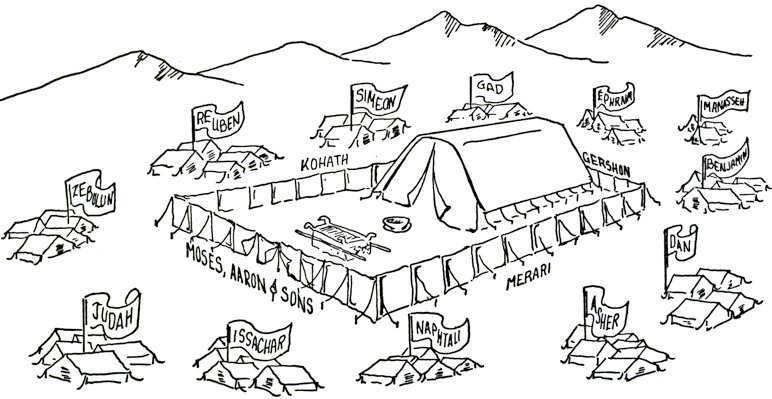
If you are interested, intrigued, confused, or just want to give me some feedback, please e-mail me direct: Contact Page
© 2014 Tricia Tillin-Booth. All rights reserved. Birthpangs Website: http://www.birthpangs.org/ This document is the property of its author and is not to be displayed on other websites, redistributed, sold, reprinted, or reproduced in printed in any other format without permission. Websites may link to this article, if they provide proper title and author information. One copy may be downloaded, stored and/or printed for personal research. All spelling and phraseology is UK English.

